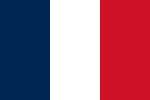| French Liberation Army | |
|---|---|
| Armée française de la Libération | |
 | |
| Active | January 8, 1943–1945 |
| Country | France Second French Colonial Empire |
| Type | Army |
| Size | 1,300,000 |
| Engagements | Italian campaign Liberation of Corsica Battle of Marseille Operation Overlord Liberation of Paris Operation Dragoon Campaign of France Colmar Pocket |
| Commanders | |
| Notable commanders | Henri Giraud Charles de Gaulle |
| Insignia | |
| Identification symbol |  |
The French Liberation Army (French: Armée française de la Libération or AFL) was the reunified French Army that arose from the merging of the Armée d'Afrique with the FFL during WWII. It participated in the Italian and Tunisian campaigns before landing in France with the allies liberating the country and occupying Germany until it had forced its capitulation in 1945.
History
The French Liberation Army was created in 1943 when the Army of Africa (Armée d'Afrique) led by General Giraud was combined with the Free French Forces (Forces Françaises Libres) of General de Gaulle.[1]
The AFL participated in the campaigns of Tunisia and Italy; during the Italian campaign the AFL was known as the French Expeditionary Corps in Italy (Corps Expéditionnaire Français en Italie or CEFI) making a quarter of the troops deployed. The AFL was key in the liberation of Corsica, the first French metropolitan department to be liberated.[1]
The troops that landed on D-Day were the 2nd Armored Division under Philippe Leclerc and the 1st Battalion Marine Commando Fusiliers (1er Bataillon de Fusiliers Marins Commandos) better known as Commando Kieffer.[2]
During the Allied invasion of Provence, on 15 August 1944, the AFL made the majority of the troops landing on French shores, capturing the ports of Toulon and Marseille.[3]. The French troops in Southern France were now named French First Army and would participated in the Liberation of France and the invasion of South-Western Germany in 1944-45. One of the AFL's garrison and second-line formations, which later helped man the French occupation zone of Germany, was the 10th Infantry Division.
References
Citations
- ^ a b Gerd-Rainer Horn 2020, p. 16.
- ^ Jean-Charles Stasi 2015, p. 16.
- ^ Paul Gaujac 2004, p. 160.
Sources
- Gerd-Rainer Horn (2020). The Moment of Liberation in Western Europe: Power Struggles and Rebellions, 1943-1948. OUP Oxford. ISBN 978-0-19-258286-7.
- Jean de Lattre (1952). The History of the French First Army. Allen and Unwin.
- Paul Gaujac (2004). Provence, August 15, 1944: Dragoon, the Other Invasion of France. Histoire & Collections. ISBN 978-2-915239-50-8.
- Jean-Charles Stasi (2015). Commando Kieffer. Heimdal. ISBN 978-2-84048-387-8.
External links
| Creation and control | ||
|---|---|---|
| Free France | ||
| Domestic operations | ||
| Underground media |
| |
| Free French Africa | ||
| Liberation of France | ||
| Leaders | ||
| Museums and Memorials | ||
| Forces | |||||||||||||||||||||||||||||||
|---|---|---|---|---|---|---|---|---|---|---|---|---|---|---|---|---|---|---|---|---|---|---|---|---|---|---|---|---|---|---|---|
| Leaders | |||||||||||||||||||||||||||||||
| Administration | |||||||||||||||||||||||||||||||
| French campaign |
| ||||||||||||||||||||||||||||||
| Aftermath |
| ||||||||||||||||||||||||||||||
| History |
| ||||||||||||||||
|---|---|---|---|---|---|---|---|---|---|---|---|---|---|---|---|---|---|
| Geography | |||||||||||||||||
| Politics | |||||||||||||||||
| Economy | |||||||||||||||||
| Society |
| ||||||||||||||||

